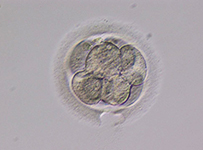Laser Assisted Hatching
Laser Assisted Hatching in ART Procedures

- Laser Assisted Hatching (LAH) is an additional lab technique designed to improve the efficiency of assisted reproductive technology procedures such as IVF & ICSI
- A shell called zona pellucida surrounds the unfertilised egg. The zona has an important role in fertilization as it allows only one sperm to penetrate the zona and enter the egg to achieve fertilization
- After fertilization of the egg, during the cleavage stage of an embryo, zona pellucida hardens. This development is normal and the purpose is to keep the cells in the egg together
- The embryos have to “hatch” or break out of the zona in order to embed into the endometrium lining of the uterine cavity. This occurs about 2-3 days after embryo transfer when the embryo is at the blastocyst stage. Naturally this takes place by expanding / contracting of the zona until it distorts, allowing the blastocyst to “hatch”
- When sperm and eggs are cultured in IVF laboratory, the zona pellucida hardens at much faster rate than in a natural cycle, making it more difficult for the embryo to implant
- Prior to implantation, the embryo has to escape out of its zona pellucida by a process known as hatching. If this process is not completed properly, implantation failure occurs and a pregnancy cannot be achieved
- Assisted hatching is the process of creating a hole in zona pellucida, to aid the embryo in the hatching process
- At Corion Fertility Clinic, we offer the Laser technology for Assisted Hatching (LAH), where a precision laser beam is focused over the zona pellucida making a small opening, between 10-20 microns to facilitate embryo hatching. LAH is done just before the Embryo Transfer
- This improves implantation and helps increase the Pregnancy rates
- A Fast, Safe & Simple method compared to the old method of hatching, which used an acidic medium (expelled onto the zona to create a small hole)
- The accuracy of the laser is predetermined by its programming, and is therefore not dependent on the skill of the operator. There is a high degree of reproducible accuracy
- We also recommend that thawed embryos should be treated with Laser Assisted Hatching before Embryo Transfer to maximize success rates
Who might benefit
- Patients with day 3 embryos having a thick Zona
- Patients with previously Failed IVF / ICSI cycles
- Women older than 37 years of age, have a tendency to produce eggs with a harder zona pellucida than younger women
- Women with a high Follicle Stimulating Hormone (FSH) level
- Patients undergoing IVF / ICSI for the first time, who are considered poor responders because they have required a high dose of gonadotropins for poor ovarian response
- Patients who in an earlier IVF cycle had low fertilization rate, resulting in three or fewer embryos
Patients who request laser assisted hatching and are fully informed of its use and function.
OUR SERVICES:
Sperm DNA Fragmentation Ovarian rejuvination Thin Endometrial Lining PGS (PGT-A) & PGD (PGT-M) Cryopreservation / Fertility Preservation / Vitrification Egg Freezing / Oocyte Cryopreservation Sperm Cryopreservation Vitrification & Frozen Embryo Transfer Recurrent Pregnancy Loss IUI-Intrauterine Insemination Blastocyst Transfer Laser Assisted Hatching Follicular Monitoring TESA-Testicular Sperm Extraction PESA – Per Epididymal Sperm AspirationCopyright © 2024, Corion. All Rights Reserved.
Website is designed & developed by Phi Brands


